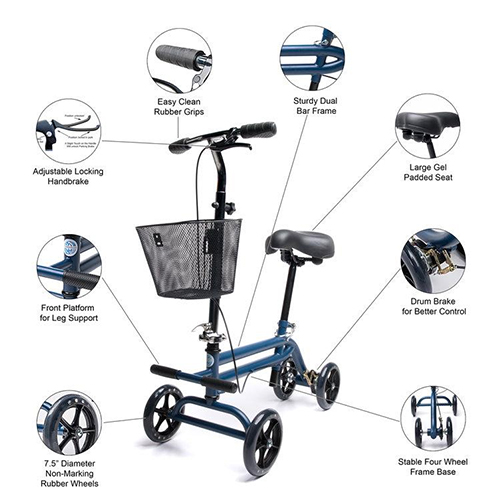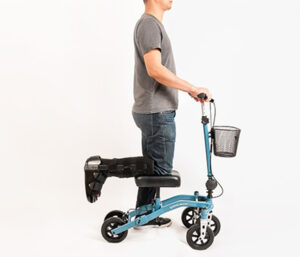Knee walkers have become a popular mobility choice for a good reason. They are a perfect upgrade from the standard crutches that we are all so familiar with. Knee walkers allow you more mobility and also allow you to completely rest, hands-free, whereas you must be standing and securing yourself at all times when utilizing crutches.
Even though knee walkers are generally a better choice for the recovery of lower leg injuries, there are still a lot of questions by the general public because they are not as well known as crutches. That is why we at Bayshore Medical Supply in Pasadena have put together this comprehensive and complete guide to knee walkers and knee scooters. We want to inform those who might benefit more from using a knee walker so they can make an informed choice as to their mobility aids.
TLDR
Feature Of Knee Walkers
While all knee walkers include some of the same features (wheels, padded “seat” to rest your knee, handlebars for steering), there are many makes and models available on the market. A few of the different options/features available include:
Brakes – Handlebar brakes similar to what you would see on a bicycle.
3 wheeled vs. 4 wheeled models – Each are sturdy, but the 3-wheeled versions are often a bit smaller and can fit into tighter spaces.
Baskets – Again, like what you might see on a bicycle, these baskets are perfect for groceries, business items, or anything else you may need to tote with you.
All-terrain wheels – These models include larger, wider wheels to allow the user to navigate rougher terrain, such as grass, dirt, or gravel-covered areas. Perfect for anyone who must spend much of their time outside on uneven terrain.
Heavyweight capacity – Some folks are simply bigger than others, so some models of knee walkers are designed to carry a much heavier weight load.
As you can see, there are quite a few options you can select with your knee walker. Just make sure that the one you choose has all the options that are suited for your needs.
How Do You Know If You Need A Knee Walker in Houston?
You may be asking, “What’s wrong with just hobbling around on a cast or using a pair of crutches or a cane that are both much less expensive?”
Good question, but in many cases, simply trying to get around using crutches or a cane is not a viable option. Here are some examples of those who would make great candidates for knee walker use:
The Elderly – The elderly who have been injured are excellent candidates for knee walker. Many older folks cannot get around easily considering the strength and balance required when using crutches or a cane. Knee walkers provide an incredible amount of stability for those in upper age ranges.
People who have very little upper body strength – When using crutches, much of your upper body muscles will be in use the whole time. People who do not have sufficient upper body strength may have serious issues when trying to use crutches. For instance, while moving about with a pair of crutches, you must engage grip strength, forearm muscles, your core (including abs and lower back to prevent soreness and injury in these areas) and even your shoulder muscles to a degree. Knee walkers require very little strength whatsoever to use making them a perfect option for those who do not possess enough upper body strength.
People who have balance issues – If someone has any type of balance issue at all, then walking with crutches is never a recommended option. This can include those with inner ear disorders, those on certain medications, etc. Knee walkers are secure vehicles and they do all the balancing for the user.
People who must be mobile for large parts of their day – Those whose jobs or familial duties require them to be mobile for much of the day are perfect candidates for knee walker. Anyone that has had to use crutches for any period know the issues: underarm rubbing causing discomfort, hand and forearm stiffness and pain from gripping the handles for extended periods of time; it’s just uncomfortable. Because knee walkers can support your entire weight and allow you to rest your hands for as long as you like, they are incredibly more comfortable than any other option, especially when one needs to be mobile for a large part of the day.
People who have certain types of injuries – Depending on what type of injury a person has, walking with crutches or a cane may not be recommended. In these cases, the jarring action associated with hobbling along on crutches can exacerbate an injury, whereas movement on a knee walker is quite smooth.
Specific Model Information
Now that you have all the info you need to make a choice, it’s time to pick out your own personal knee walker. If you are in the Houston area, then Bayshoremedicalsupply.net is the place to go. They have a huge selection of all kinds of medical equipment including top of the line knee walkers that have all the features mentioned above. These models include:
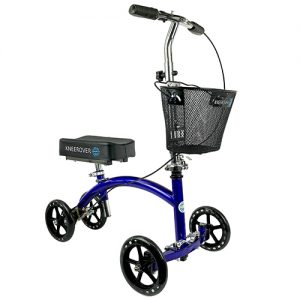 The KneeRover Deluxe– A top of the line design, 4-wheel model that has extra padding for your knee, a large transport basket and tie-rod steering for maximum stability and safety.
The KneeRover Deluxe– A top of the line design, 4-wheel model that has extra padding for your knee, a large transport basket and tie-rod steering for maximum stability and safety.
- Offer an advanced automotive style tie-rod steering mechanism and an adjustable locking handbrake.
- Features four 7.5″ non-marking rubber wheels, a comfortable 3″ thick contoured knee platform that is left or right leg compatible, and a free basket.
- Has a removable front axle and handlebars with a quick folding mechanism for easy transport and storage.
- Fully adjustable handlebars and knee platform,
- 300 lb weight capacity and is recommended for individuals with heights 4.9′ – 6’6″.
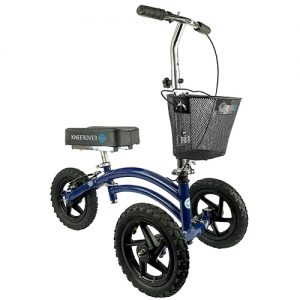 The All-Terrain KneeRover– This kneerover is a steerable knee scooter in the industry, establishing a new level of durability and freedom of mobility for individuals who cannot bear weight on their foot or ankle, yet want to remain active.
The All-Terrain KneeRover– This kneerover is a steerable knee scooter in the industry, establishing a new level of durability and freedom of mobility for individuals who cannot bear weight on their foot or ankle, yet want to remain active.
- This indoor/outdoor all terrain knee scooter features 12-inch pneumatic tires
- This steerable knee walker offers an advanced automotive style tie-rod steering mechanism (not available on most knee walkers) and an adjustable locking handbrake.
- Fully adjustable knee platform and handlebars with easy folding mechanism for simple transport and storage of rolling knee walker.
- 350 lb weight capacity and is recommended for individuals with heights 5’6″ – 6’5″.
 The KneeRover Jr.- A high quality kneerover made just for kids and smaller adults.
The KneeRover Jr.- A high quality kneerover made just for kids and smaller adults.
- The first pediatric steerable knee scooter designed specifically for kids and smaller adults who cannot bear weight on their foot or ankle yet want to remain active and mobile.
- Excellent stability and safety with its sturdy dual bar design, unique 4-wheel frame, adjustable handbrake and rear drum brake.
- Weighs only 18 pounds,
- 3″ thick contoured knee platform and ergonomic rubber hand grips for complete comfort.
- Easy to use thumb-release lever. Additionally, this knee walker is equipped with a free detachable storage basket and features tool-free assembly & setup.
- Lightweight yet sturdy knee walker offers a 160 lb weight capacity and is recommended for children and small adults with heights 3’9″ to 5’6″.
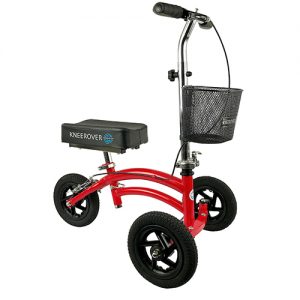 The KneeRover Jr. All Terrain– You guessed it, just like the kneerover jr. model but with larger tires designed to allow users to get around just about anywhere.
The KneeRover Jr. All Terrain– You guessed it, just like the kneerover jr. model but with larger tires designed to allow users to get around just about anywhere.
- Outdoor mobility for individuals (4’3″ feet to 5’9” tall) who cannot bear weight on their foot or ankle yet want to remain active and mobile.
- An advanced automotive style tie-rod steering mechanism and an adjustable locking handbrake.
- Includes the New KneeRover® Stabilizer training wheel for maximum stability and control.
- Features three 9″ diameter air-filled tires and a 3″ padded knee platform that is left or right leg compatible.
- Features tool-free setup and assembly, along with a hand rim brake.
- Equipped with an easy folding mechanism that collapses via a thumb-release lever.
- It also comes with a FREE detachable basket for storage of your personal belongings.
 The Seated KneeRover– This model lets you truly sit down and elevate the injured leg for maximum comfort.
The Seated KneeRover– This model lets you truly sit down and elevate the injured leg for maximum comfort.
- Adjustable locking handbrake and rear drum brake.
- Seated mobility scooter features a large gel padded seat,
- Ergonomic rubber hand grips
- Front leg platform that allows the patient to rest in comfort while elevating the non-weight bearing leg.
- Handlebars with a quick folding mechanism for easy transport and storage.
- Walker also comes with four 7.5″ non-marking rubber wheels, and a free basket.
- Robust 300 lb weight capacity and is recommended for individuals with heights 5″ – 6’6″.
Frequently Asked Questions About Knee Walkers
Can You use a Knee Walker on Carpet?
All knee scooters can be used on any surface including carpets, concrete, hard and floors, light dirt. There are even all terrain models incase you plan on going over a lot of different surfaces that are not smooth or even.
Is there a difference between knee scooters and knee walkers?
Though you might hear the different terms knee walker and knee scooter, they are actually different terms for the same piece of medical equipment. So the two terms are actually interchangeable.
How can I make my knee walker more comfortable?
You can purchase a knee pad cover that can provide extra comfort while preventing your leg from sticking to the pad.
Can I use a knee walker on stairs?
The simple answer is no, it would not be safe to use a knee walker on stairs. If you live in a two-story home and need to get upstairs, it would be best to have a sturdy handrail and use a cane or crutch. You might want to get two knee walkers and keep on upstairs as well as have one downstairs.
Can I use a knee scooter with a cast?
You can use a knee scooter if you have a cast in your lower leg or foot. Knee walkers are actually great for getting around longer distances where it can be hard to walk on a below knee cast or plaster or fiberglass cast.
Can I travel with a Knee Walker?
You can absolutely travel with knee walkers. There are even foldable versions to make them easier to stick in the trunk of a car or take them on public transit.
How to Use a Knee Walker
You first want to adjust your knee walker to your height. The height of the knee pad and the steering column are the most important things to have set correctly. After you have your knee walker adjusted, you rest your injured foot on the padded knee rest. Grab on to both handlebars. Then, you push yourself forward with your good foot. As you move, use the handbrakes as needed (the same as bicycle brakes).
Knee Walker Safety Tips.
Here are some quick safety tips on how to use a knee walker.
- Lock in the brakes when you get on and off the knee walker. This prevents the knee walker from rolling away from you when getting on and off the device.
- Use caution when moving downhill, it’s easy to increase your moving speed so use your hand brakes to regulate your speed.
- Do not sit and ride your knee scooter. It easy to lose your balance and fall this way.
- Be careful when you change riding over two different surfaces. The change and cause a bump, making it easy to lose balance and fall.
· Make sure the knee walker is adjusted properly to your height and comfort. Your hand should be able to comfortably rest on the handlebars. Your leg should be able to bend about 90 degrees without having to squat.
Bayshore Medical Supply is in Pasadena TX and is the surrounding Houston area’s source for knee walkers and medical rental equipment. Bayshore offers knee walkers for rent and for sale, as well as other mobility products so patients can make the best solution for their lifestyle.

